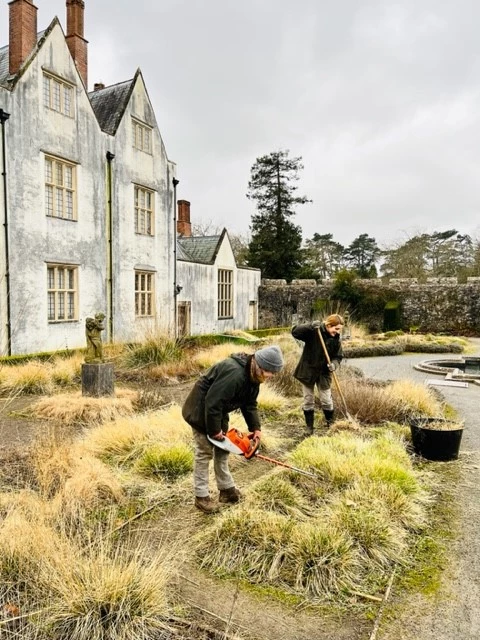March is for mulching
, 16 Mawrth 2023
If you are visiting St. Fagans this month you will notice an army of gardeners and volunteers marching around the gardens with wheelbarrows full of organic matter to condition the soil of our beautiful gardens. As winter comes to an end, spring arrives with a promise of growth. This is a crucial moment in the gardening calendar to prepare for the warmer months ahead.
Because of the over-emittance of greenhouse gases, the Earth’s surface temperature is increasing rapidly. We are noticing summer months that are hotter and drier than ever, only last year we witnessed temperatures around 40°C in some areas of the UK. The excessive heat and prolonged drought have devastating effects on our local flora and fauna.
One of the most important tasks for this month is to mulch the soil by adding a layer of organic matter to the soil surface. Mulching brings numerous benefits to plants including moisture retention in periods of drought, weed suppression, improvement of soil structure and fertility, reducing the need for artificial fertilisers, prevention of soil erosion, and encouragement of beneficial organisms such as earthworms, soil bacteria and fungi. Additionally, it attracts wildlife to our gardens, one of my favourite memories is of being followed by Robins as we mulch the garden in spring. They patiently wait for a feast of earthworms, while gifting us with their beautiful bird song announcing the arrival of spring.
There are many different types of mulching materials and each with their own benefits and uses. Most of our gardens are mulched with well-rotted farmyard manure sourced from Llwyn-yr-eos farm in St. Fagans and from a local farmer. The manure is gradually incorporated into the soil by the activity of earthworms and other microorganisms, which improves the soil structure and supplies the plants with nutrients. This nitrogen rich material is ideal to be used on herbaceous borders, vegetable beds, roses and newly planted trees and shrubs.
However not all plants like nutrient rich mulches, plants that are adapted to growing in hot and dry conditions often do not cope well with excessive moisture and high fertility. For example, in the Herb Garden where we have Mediterranean plants such as lavender, rosemary, sage and thyme we have opted for mulching the beds with gravel. This is an inorganic material that does not break down; therefore it does not release nutrients to the soil. In addition, gravel is great at promoting good drainage, suppressing weeds, and adding aesthetic value to the garden.
This year we are trying new methods of mulching as a sustainable way to utilise the maximum of our local resources. We have started using raw wool provided by the Llwyn-yr-Eos farm to mulch the vines in the greenhouse. This will help with water conservation and prevention of weeds. Besides the wool fleece degrades slowly releasing nutrients into the soil and feeding the vines. Another advantage is that wool can help retain heat during colder months, keeping the root of the vines warm in winter.
In March we cut back the ornamental grasses and perennials of the Dutch garden and a large amount of material usually ends up in the compost heap. This year we decided to skip this process and instead we added the dried grass clippings directly to the surface of the pumpkin patch. We have sprinkled a fine layer of manure on top to weigh down the grasses and prevent them from blowing in the wind. This will also aid the process of decomposition by introducing nitrogen to this carbon rich material. While the farmers make hay for a rainy day, the gardeners mulch with hay for a hotter day.
When choosing mulches or growing mediums for your garden, prefer materials from sustainable and local sources in order reduce the carbon footprint from transportation. It is also important to avoid peat-based composts at all costs. The extraction of peat has a negative impact in the environment, it destroys the natural habitat of many species that live in peatlands, besides it releases tons of carbon dioxide into the atmosphere contributing to the greenhouse effect.
For the home gardener the most sustainable and cost-effective option is to mulch using homemade compost or leaf mould. Why not try making your own compost using kitchen and garden waste? You will be surprised at the benefits you can reap from your compost heap.


